In this post, you’re going to learn everything you need to know about running postpartum.
Specifically,
- When can you run after giving birth
- How to begin running postpartum, and
- What to expect running after a C-section
In general, you can begin running 6-12 weeks postpartum depending on the delivery you had. But before you start, it’s important that you strengthen your core and pelvic floor muscles first.
Keep reading to learn more.
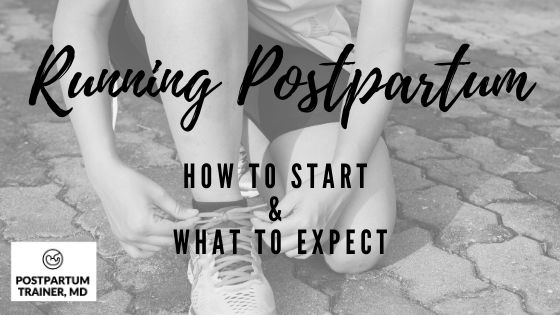
How Soon After Giving Birth Can You Run?
So when can you run after giving birth? Well, it depends on the type of delivery you had.
If you had a vaginal delivery you might want to wait at least 6 weeks before running.
While this may sound like a long time, you may be surprised at how difficult it can be to get back to running after having a baby.
If you had a c-section, you will need to wait even longer. More on that below.
Running is a very stressful thing for your body. That’s why you need to give it time for your body to fully recover from the pregnancy and the delivery.
If you introduce a new stressor into your life like running- it can negatively impact your healing and lead to pain.
With that said, if you were a regular runner before your delivery, your body might be ready sooner.
As always, it is important to have a thorough check-up at your 6-week postpartum visit.
Running After A C-Section
If you had a c-section, it is best to wait closer to 12 weeks before starting a running routine.
Why so long?
Because c-sections are major abdominal surgery.
Several layers of tissue are cut during the surgery, and they must all come back together. This process takes a minimum of 6 weeks.
At your 6 weeks postpartum visit, you will have your vital signs checked, and your incision inspected. If everything looks good, your doctor will clear you for physical activity.
But here’s the catch…
Your doctor won’t explicitly tell you how to resume exercise.
If it isn’t obvious, you shouldn’t go right back to your pre-pregnancy running routine right away.
Once you’re doctor clears you for physical activity, you should start by introducing gentle exercise into your daily routine.
This means progressing from
- walking -> brisk walking -> alternating walking with light jogging -> and so on.
There should be small but measurable progress in your running routine.
See below on how to create a routine for yourself.
The most important part is that you should not be in any pain! If you start to develop any significant hip pain, knee pain, or foot pain, stop!
I’ll explain more in a bit.
In the meantime, this is what you should do for the first 6 weeks to prepare yourself.
Is Running Good For Postpartum?
Any type of exercise can be good for you in the postpartum period. You just have to make sure that you’re ready for it.
Running too soon in the postpartum period can lead to pain, muscular/joint injuries, and worsening of pelvic floor dysfunction.
Rather than jumping right into running after your delivery, I recommend that you begin by strengthening your core and your pelvic floor first.
- Your core involves all of the muscles in your midsection. This includes your abs (aka rectus abdominis) your obliques (located on the sides of your rectus abdominis) and your transverse abdominis (located deep to the rectus abdominis muscles).
- The pelvic floor is a group of muscles that support the organs near your rectum and vagina. It kind of acts like a sling, holding everything up.
How To Strengthen Your Core
You can begin strengthening your core within the first 2 weeks postpartum, starting with deep diaphragmatic breathing and pelvic tilts.
You can learn all about diaphragmatic breathing and pelvic tilts here.
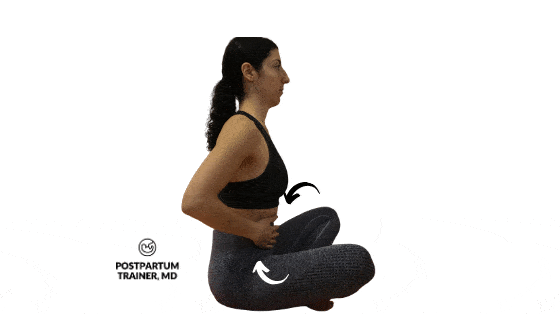
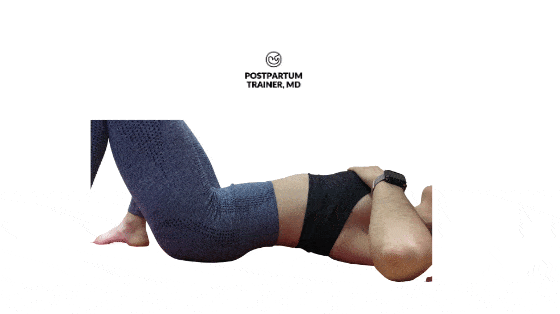
After about 4-6 weeks, you can begin introducing other gentle core exercises that I outline in my post on how to train your core postpartum.
In brief, you need to focus on re-engaging your core muscles.
This is especially true if you have Diastasis Recti, a condition in which your ab muscles separate along the midline during the labor process and don’t come back together again. If you’d like to perform additional exercises to correct your diastasis recti, check out my post on 100 exercises to fix diastasis recti.
You can do these gentle core exercises alongside your running routine.
Strengthening Your Pelvic Floor
Secondly, I want you to do pelvic floor exercises within the first week of delivery.
Strengthening your pelvic floor is extremely important postpartum because these are muscles that get extremely weak during pregnancy.
Weak pelvic floor muscles can increase the risk of urinary incontinence and pelvic organ prolapse, especially if you start running too soon.
Start strengthening your pelvic floor with the Kegel exercise listed in the post on strengthening the pelvic floor.
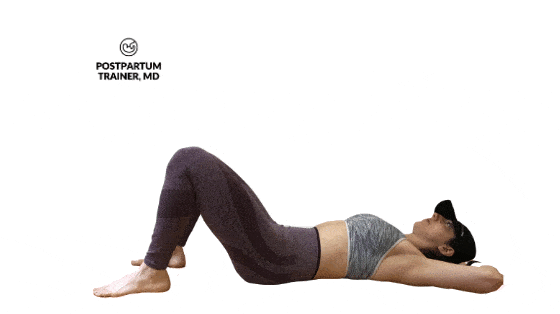
Do these, along with the pelvic tilts and deep diaphragmatic breathing a day or two after delivery.
You can then include the bridge, and the squat slowly as your body begins to feel ready for it.
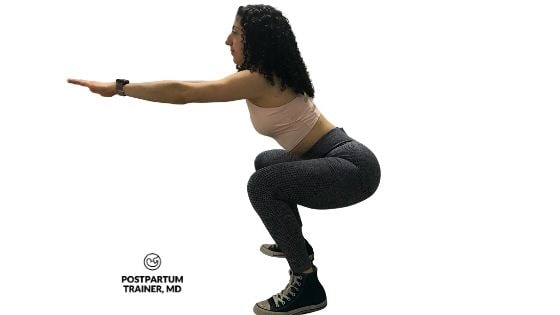
In Summary
- After you deliver, begin doing basic pelvic floor and core exercises within 1 week of delivery.
- In weeks 1-4, walk as much as you can, and continue doing your basic pelvic floor and core exercises at least 4 times per week
- Whenever you feel ready, start incorporating gentle core exercises to your routine by week 6. (This may take longer if you had a C-section)**
How To Build Up To Your First Postpartum Run
After you begin core and pelvic floor work, now it’s time to strengthen the rest of your body. This includes the muscles of your legs and glutes.
During pregnancy, your body releases a hormone called relaxin. This hormone is responsible for making your bones, joints, and muscles more lax.
Relaxin is responsible for making the muscles and joints in your hips expand to accommodate your growing uterus.
The problem is…
This hormone lingers in your body for weeks after you deliver.
This is why it is really important that you not run too soon after delivery.
So instead, I recommend that you strengthen these muscles first.

Strengthening Your Legs
The first muscle group you should work on are your legs. These include the quadriceps, the adductors, and your hamstrings.
By strengthening these muscles, you reduce the risk of straining them while you run.
I have an entire post on safe leg exercises you can do in pregnancy and postpartum.
Pick 2-3 of them and let’s move on.
Strengthening Your Glutes
The second muscle group you need to strengthen is your glutes – aka your butt.
The glutes are such an important muscle group because they are responsible for keeping you upright and stabilizing your pelvis.
Almost all pregnant women develop weak glutes in pregnancy, which increases your risk of low back pain and injury.
To strengthen your butt muscles, I have an entire post on the best glute exercises for the postpartum period.
Pick 2-3 exercises to focus on.
Lastly, here is a post on strengthening your arms, because, why not? 🙂
Now, I think you are ready to begin a running routine.
Putting It All Together
- Begin doing the basic pelvic floor and core exercises within 1 week of delivery.
- In weeks 1-4, walk as much as you can, and continue doing your basic pelvic floor and core exercises at least 4 times per week
- In weeks 4-6 (or whenever you start to feel ready and have medical clearance) begin incorporating gentle core exercises to your routine. (This may take longer if you had a C-section)**
- By week 6, start to strengthen your arms, legs, and glutes. (This may take up to 12 weeks if you had a C-section)**
- By week 6-12 you can start building up to your first run (This may take longer if you had a C-section)**
Some of these steps can overlap. For example, you can start strengthening your arms, glutes, and legs at the same time that you are doing the core exercises.
Keep in mind that these are rough guidelines. Your recovery timeline may be a little faster, or a lot slower than this.
**THE MOST IMPORTANT THING IS THAT YOU TAKE YOUR TIME AND AVOID ANYTHING THAT HURTS**
Always see your doctor before starting any physical activity, and consider seeing a physical therapist if you have any other concerns.
Okay, I’m Ready. How Do I Get Back To Running After Having A Baby?
Okay, so you strengthened your pelvic floor, your core, and your legs/glutes.
Right?
Alright, I believe you.
To get back to a running routine, it is important to take things slow. You should already be comfortable walking for moderately long distances by now.
Before you begin your run, it’s a good idea to stretch your hip flexors and your quadriceps. This is what it looks like.


Postpartum Running Plan
Okay, now it’s time for the running plan!
Here is a simple routine you can follow to get you ready to run again.
Keep in mind, this plan should not be started until at least 6 weeks postpartum!
If you’re less than 6 weeks out, focus on the exercises above first.
Okay, let’s get started.
Week 1: Brisk Walk Intervals
In week 1, I want you to begin with brisk walks.
A brisk walk is when you walk at about an 8/10 speed. 10/10 is the fastest pace you can possibly walk.
Alternate between an 8/10 brisk walk for 1 minute, followed by a normal paced walk for 1 minute. Do this for up to 30-minutes.
As you get stronger, increase the brisk walk by 15-30 seconds, and decrease the normal paced walk by 15-30 seconds.
This will help bring your heart rate up and increase circulation to the rest of your body.
Do this up to 3 times per week.
Week 2: Brisk Walk Intervals On A Hill
For the second week, I want you to use the same interval:
1 minute of brisk walking alternating with 1 minute of walking on a hill.
If you can find a hill to do this great. If not, you can use a treadmill. Increase the incline setting to 3-4.
A hill will make the workout much more challenging, and further improve your endurance.
Again, you can increase the brisk walk by 15-30 seconds, while decreasing the normal walk by 15-30 seconds. Work up to a 30-minute workout.
Do this up to 3 times per week.
Week 3: Jogging Intervals
Now that you feel comfortable brisk walking on hills, it’s time to start jogging.
Similar to what you did in week 1, I want you to jog at a comfortable pace for 1 minute intervals.
Aim for a 6/10 speed- with 10/10 being an all-out effort jog. Alternate this with 1 minute of brisk walking.
Work up to a 30-minute workout alternating jogging with brisk walking.
Do this up to 3 times per week.
Weeks 4-5: Continuous Jogging (Hills Are Optional)
For the following week, you can try to jog continuously.
You may find that you will still have to alternate between a jog and a brisk walk and that is okay!
As you continue to improve your endurance, try to jog continuously for a full 30 minutes.
You can even play around with the incline setting and jog on a small hill.
Do this up to 3 times per week.
Week 6: Running
Okay, you made it!
At this point, you should be able to begin running again. Feel free to use a similar progression as you did in weeks 3 through 5.
Start by running at about a 4/10 speed, or less than half of what your top speed would be. If you need to go slower, go slower. You should be able to find the pace and rhythm that works with you.
Aim for a 30-minute workout, 3 times per week.
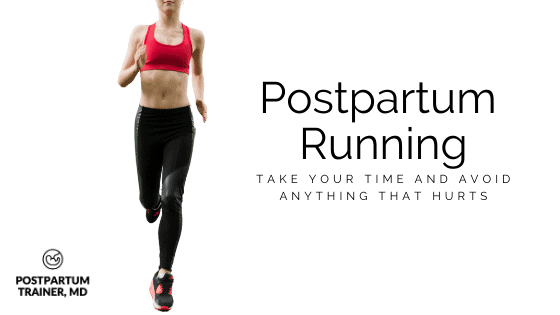
Things To Look Out For When Running Postpartum
In this next section, I want to highlight things you should look out for when running postpartum.
You will be exhausted
The postnatal period is often a time of fatigue, sleep deprivation, and stress. Don’t be shocked if you have very poor endurance and you can’t run very often.
That’s why you need to follow a gradual step-by-step program.
Your feet may still be swollen
A lot of the excess fluid that your body accumulates during pregnancy often pools in your lower body. After you give birth, all of this extra fluid doesn’t just disappear.
Expect your feet to be swollen and sometimes uncomfortable.
You may have to go up half a size in your running shoes. The Saucony Guide women’s running shoes are always rated the highest in terms of comfort and quality.
Another good brand that is always a top seller is The Brooks Adrenaline shoe.
You have increased laxity in your ligaments
Remember that relaxin hormone I was talking about? The one that makes your joints and muscles more lax?
Well, that’s another reason why you need to wait before you can start running.
You can help decrease this laxity by strengthening the muscles of your legs, core, and glutes as I showed you above.
That laxity can lead to…
Aches and pains in your hips
Studies show that postpartum runners can often experience pain in the hips and low back. I have written an entire post on postpartum back pain and how to get relief at home.
Making sure that you are strengthening your core properly, and taking your time to ease into your routine is key.
If you experience significant discomfort, you should definitely see a specialist before running regularly.
You may experience urinary incontinence
The last thing you need to look out for is urinary incontinence. This is when you involuntarily leak urine whenever you cough, sneeze, laugh, or exercise.
This is known as stress urinary incontinence.
It is common to experience this after delivery, and pelvic floor exercises are the best way to treat it.

If you do not notice an improvement in your symptoms after a few weeks of pelvic floor work, go see your gynecologist for further work-up.
Okay, now let’s finish up with a few other questions.
Can I Run While Breastfeeding?
Yes, you can run while breastfeeding. It is important to time your run after you nurse because running with full breast might cause pain as well as leaking.
Generally it is a good idea to:
- massage your breasts prior to your run to start the flow of milk using this awesome device that applies both vibration and heat
- empty your breasts using this hands free manual pump while breastfeeding your baby on the opposite breast, or this portable hands free wireless pump if you want to multitask before your workout 🙂
- put on these breast shells to collect any milk that happens to leak during your workout
Another important thing to keep in mind is that your breast will be heavy and sore.
The physical impact of running can cause more pain and discomfort if your breasts aren’t well supported.
Be sure to get yourself a good support bra to prevent your breasts from bouncing too much.
This sports bra on Amazon has great reviews.
Will Running Affect My Milk Supply?
No, running/exercise will not affect your milk supply. Studies have confirmed this.
To ensure that you have a steady supply, it is important that you do three things.
- Pump or nurse every 3 hours: Inadequate breast stimulation may lead your body to slow down the rate of milk production.
- Eat enough calories: Women who breastfeed need to consume an additional 300-500 calories per day. If you do not provide your body with the energy to create milk in the first place, your milk supply will suffer.
- Stay hydrated: You need water for everything. Breast milk is mainly composed of water. Do not make the mistake of forgetting to drink water throughout the day. Your body and your baby will thank you.

Should I Get A Jogging Stroller?
I want to just end with a quick word on jogging strollers.
These are a great way to go for an outdoor run with your baby. Some women love them, and other women find that it can affect their running form.
With that said, it is recommended you wait until your baby is at least 6 months before using one.
Before 6 months, your baby won’t have full control of his/her head. Any impact you might encounter during running can jerk your baby’s head around and cause damage to his/her neck.
If you want to try one, expect to pay around $200-500 for a good quality jogging stroller. Here are the best ones on Amazon.
The Biggest Take Away Is: Always Listen To Your Body!
As with all things in life, everyone is different. I want you to really listen to your body as you are starting a running routine.
Don’t be afraid to take it slow, especially if you had a C-section.
Follow an incremental program like I have above and you should be well on your way back to a good running routine.
For additional information on running in the postpartum period check out my Guide to Getting Fit After Pregnancy.
Did you run a lot before pregnancy?
Have you started a postpartum running routine?
Comment below and let me know!
Articles Related to Postpartum Exercise
- 9 Easy Leg Exercises for Pregnant and Postpartum Women
- 100 Amazing Exercises to Rebuild Your Core
- How to Train Your Abs After Having a Baby
Get Four Free Workouts To Help Strengthen Your Pelvic Floor & Heal Your Mommy Tummy!

Brittany Robles, MD, MPH, CPT
Brittany Robles is a full-time OBGYN physician, a NASM certified trainer, and a prenatal and postnatal fitness specialist. She holds a Master of Public Health degree in maternal health with a special interest in exercise and nutrition. She is also the co-author of The White Coat Trainer. Learn more about her here.
Sharing is Caring – Send This To A Mom In Need!
